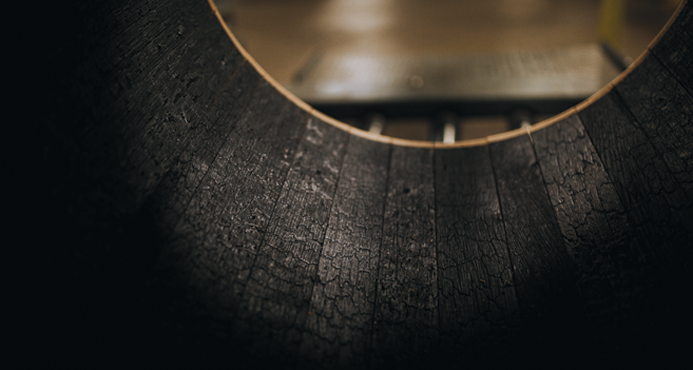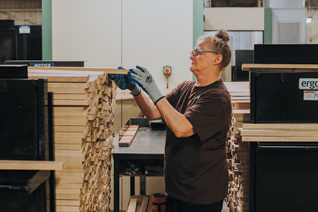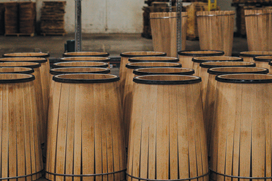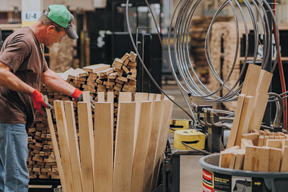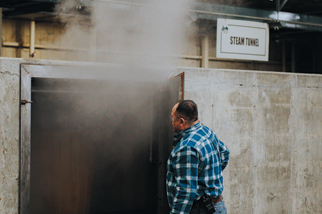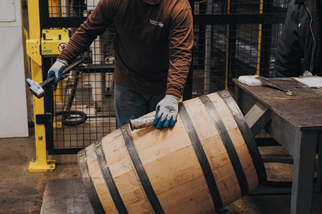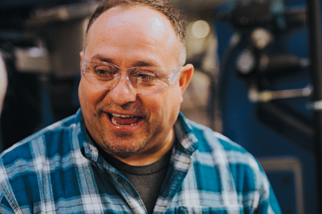Roll Out the Bourbon Barrel
In the wooded hills of Ohio’s sparsely populated Appalachia lies the small town of Jackson. It is a 2,100 mile journey—and a climate and a culture—away from Guadalajara, Mexico’s second-largest city and the birthplace of Alberto Ramirez, production manager of Speyside Bourbon Cooperage in Jackson.
Edible visited Alberto there to learn about bourbon barrels and the man who directs their manufacture.
A Journey in Wine and Spirits
Dressed in jeans and a flannel shirt, Alberto exudes a contained energy, as if ready to spring into action wherever he’s needed. Alberto, 43, came with friends to California in 1993 to “explore and see something different” for a few months. He found work in a winery, “first on the grape side, then on the barrel side,” where he learned from a master cooper the age-old craft of barrel making. Alberto also fell in love and married in 1995. “Now I was paying bills, I had responsibilities.” He decided to stay in the country and become a citizen.
Growing up in Jalisco, the heart of tequila country, Alberto knew tequila. This job meant that he had to “develop a taste for wine.” He had become assistant production manager at the wine cooperage when parent company Brown-Forman asked him to move to Louisville, Kentucky, in 2006 to work as production manager at their whiskey cooperage.
Alberto chuckles. “Then I had to develop a taste for bourbon.”
The Bourbon Barrel
When America was young, Kentucky makers distilled bourbon from a fermented mash (mostly corn) and shipped it down the Ohio and Mississippi Rivers in barrels made of the region’s plentiful white oak. It aged en route and was decanted into bottles when it reached its destination. Transportation was expensive, so barrels were not shipped back upriver for re-use.
Eventually, distillers realized that using new barrels made the bourbon taste better. Alberto explains: “There’s a science to it, in drying the wood, understanding that it is a container but it’s also a key ingredient to make products—without new barrels you can’t make Kentucky bourbons.” Indeed, he assures us, “100% of bourbon’s color and 60% of its flavor” comes from the barrel itself as the bourbon moves in and out of the wood.
The barrel is “toasted” using indirect heat, Alberto says “to caramelize the sugars in the white oak cells.” Then, a direct flame chars the barrels’ interiors. Historically, charring was a means of sterilizing and neutralizing any lingering flavors from the barrel’s previous contents. In l935, Congress mandated that bourbon be aged in “charred new oak containers.” Today’s distillers value the char for its ability to further extract the flavors of the oak’s tannic acids and vanillins.
From Master to Manager
Alberto’s journey continued: 2010, mill manager at the stave mill in Clifton, Tennessee, learning the business side of cooperage; 2013, production manager at Jack Daniel’s Cooperage in Decatur, Alabama; 2015, a move to Shepherdsville, Kentucky, to oversee the building of a new cooperage, this time employed by Speyside, a subsidiary of French company Tonnellerie François Freres.
“But then this facility in Jackson, Ohio, became available, right where the white oak grows, and Speyside decided to move here.” Alberto helped design the layout of the state-of-the-art, 250,000-square-foot manufacturing floor, and in 2017 he moved to Jackson with his two children to become cooperage production manager.
Alberto remains modest about his achievement. He says that he is responsible for “everything” at the cooperage, but immediately adds: “I don’t believe in titles. What counts is what you bring to the table, what you do for your people.”
A Barrel of Fun
Alberto shows us outside, where four separate yards house towering stacks of freshly milled staves (thin pieces of wood that comprise the barrel), enough for a jaw-dropping 114,000 barrels. After six to nine months of air drying, their moisture content drops from around 60% to 30%.
“Quarter-sawn white oak,” Alberto says, “80% of it comes from a mill 20 miles down the road. We dry the wood very slowly. Too much heat damages wood and fractures the fibers. Then it will break when bent.”
Alberto notes that any scrap lumber and sawdust feed the steam boiler that heats the cooperage, making it self-sustaining.
Inside, the building is clean, the noise spectacular. We don safety glasses and ear plugs and watch multiple forklifts shifting the staves, which spend four to seven weeks undergoing two more drying processes. At 13% moisture content, the staves move to the drystorage area to await their destiny.
Roll Out the Barrel
Compared to the lengthy drying process, barrel making is speedy, to the tune of 1,200 barrels per day. Speyside’s manufacturing line has one aim: to automate each step of barrel making, taking it from a craft to a manufacturing process, always emphasizing employee safety.
For example, stave jointing—the measuring, cutting and planing of each unique stave—is completely computerized, requiring a worker only to feed in and inspect the staves. Next, to use the cooper’s vernacular, a worker “raises a barrel” by inserting staves into a temporary ring, where they bloom out like flower petals.
Following a trip through the 75-foot-long steam tunnel, the barrel’s staves are pliable enough to bend. The barrels are toasted under 12 burners at 1,000-plus degrees to caramelize the oak sugars, then charred, three barrels at a time, in a protective steel cage.
Once torched with natural gas and air, the barrels catch fire and burn to their desired level of char, an average of 35 seconds, before water extinguishes the flames. The “heads” (top and bottom) are charred separately in the “pizza oven,” then rolled on edge in melted food-grade wax and “seated” or attached to the barrel.
The pre-finished barrel travels through a cooling line and receives its head, bilge and quarter hoops of black steel, each bearing their brand rivet “S” for Speyside. The barrel itself receives no rivets, no nails, no glue.
Alberto often quizzes his staff: “What holds a barrel together?” The right answer: “Pressure and perfect joint.”
The last step: drilling the barrel’s bunghole in the top or side, depending on the customer’s preference. After a leak test, the finished barrels move in lots of 288 to one of nine loading bays for customer pickup.
A cooper, one of several trained by Alberto himself, stands by to disassemble, repair and reassemble the few barrels that fail the leak test.
Old Barrels Never Die . . .
Speyside’s barrels travel the world. In Columbus, Middle West Spirits’ Ryan Lang calls the barrels “second to none,” adding that “the products produced from their barrels and custom char levels are exceptional.”
Max Lachowyn, the production manager at Waterside Distillery, praises Speyside’s “impeccable customer service” and their production of a “high-quality barrel right here in Ohio from Ohio oak.” Watershed re-uses the barrels for their Bourbon Barrel Gin.
After 35–40 years of service, a barrel may retire to spend its golden years as a planter, or more ignominiously, as a trash container. Hot tip from Alberto: The hoop rivet on a Cracker Barrel planter will likely carry the letter of its cooperage.
Speyside BCI now employs 140, and is still hiring for second shift. “We are definitely helping the community big time economically,” Alberto says. “Our employees have benefits—dental, medical, 401(k)s and”—he launches his punch line—“they get to work with me.”
He is joking, but he knows his workers by name. Looking back, he is happy with his decision to become a U.S. citizen. His daughter Eileen is poised to attend dentistry school. Son Erik dreams of becoming an aeronautical engineer.
“I’ve been blessed,” Alberto says simply. “The opportunity came along, and I was in the right place at the right time.”
Speyside Bourbon Cooperage is located in Jackson, Ohio, about 90 miles south of Columbus. Find out more at www.speysidebci.com


